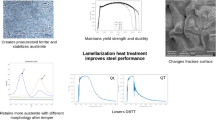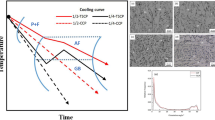Abstract
The effect of a lattice curvature on impact toughness at low temperatures is studied for the 09Mn2Si and 10Mn2VNbAl high-strength low-alloy (HSLA) steels having different compositions of doping elements. It is shown that the formation of the lattice curvature (several degrees/micrometer), in particular by helical rolling, significantly increases the low-temperature impact toughness of the HSLA steels, regardless of the alloying element compositions. This means that the observed effect could be characteristic of other HSLA steels subjected to complex thermo-mechanical treatment with the formation of the lattice curvature of a certain degree. Authors suggest that the perlite \(\rightarrow \) bainite phase transformation develops under helical rolling at a temperature of \(\sim \) \(850\,^\circ \hbox {C}\). As a result, bainite is formed in the lattice curvature zones characterized by the presence of interstitial mesoscopic structural states where random rotational deformation modes could develop. This drastically improves the low temperature impact toughness of the HSLA steels and contributes to enhance their fatigue life and wear resistance.








Similar content being viewed by others
References
Gautier, D.L., Bird, K.J., Charpentier, R.R., et al.: Assessment of undiscovered oil and gas in the arctic. Science 324(5931), 1175–1179 (2009). https://doi.org/10.1126/science.1169467
Gorynin, I.V., Khlusova, E.I.: Nanostructured steels for developing the shelf of the Arctic Ocean. Her. Russ. Acad. Sci. 80(6), 507–513 (2010). https://doi.org/10.1134/S1019331610060067
Il’in, A.V., Filin, VYu.: On the ratio of local and energy criteria of unstable cleavage fracture of cold-resistant steel. Inorg. Mater. 50(15), 1543–1548 (2014). https://doi.org/10.1134/S0020168514150047
Yan, J.-B., Liew, J.Y.R., Zhang, M.-H., Wang, J.-Y.: Mechanical properties of normal strength mild steel and high strength steel S690 in low temperature relevant to Arctic environment. Mater. Des. 61, 150–159 (2014). https://doi.org/10.1016/j.matdes.2014.04.057
Zia-Ebrahimi, F.: Ductile-to-brittle transition in steel weldments for arctic structures. Fracture and Deformation Division Center for Materials Science National Bureau of Standards, NBSIR 85-3020 (1985)
Walters, C.L.: The effect of low temperatures on the fatigue of high-strength structural grade steels. Procedia Mater. Sci. 3, 209–214 (2014). https://doi.org/10.1016/j.mspro.2014.06.037
Ghosh, A., Ray, A., Chakrabarti, D., Davis, C.L.: Cleavage initiation in steel: competition between large grains and large particles. Mater. Sci. Eng. A. 561, 126–135 (2013). https://doi.org/10.1016/j.msea.2012.11.019
Filin, V.Y.: Quality control of steels for large-sized welded structures of the Arctic shelf: application of Russian and foreign requirements. Inorg. Mater. Appl. Res. 10, 1492–1503 (2019). https://doi.org/10.1134/S207511331906008X
Russian Maritime Register of Shipping: Rules for the Classification, Construction and Equipment of Mobile Offshore Platforms. Russian Maritime Register of Shipping, Saint-Petersburg (2012)
Layus, P., Kah, P., Ryabov, V., Martikainen, J.: Evaluation of applicability of thick E500 TMCP and F500W QT steel plates for Arctic service. Int. J. Mech. Mater. Eng. 11(4), 1–15 (2016). https://doi.org/10.1186/s40712-016-0057-z
Oryshchenko, A.S.: Creating weldable high-strength structural steel with nanostructuring. Steel Transl. 47(11), 717–721 (2017). https://doi.org/10.3103/S0967091217110080
Gusev, M.A., Dmitriev, A.A.: Bifurcational behaviour of potential energy in a particle system. Phys. Mesomech. 16(4), 287–293 (2013). https://doi.org/10.1134/S1029959913040024
Matsukawa, Y., Steven, J.Z.: One-dimensional fast migration of vacancy clusters in metals. Science 318, 959–962 (2007). https://doi.org/10.1126/science.1148336
Steed, J.W., Atwood, J.L.: Supramolecular Chemistry, 2nd edn. Wiley, Hoboken (2009)
Panin, V.E., Panin, A.V., Perevalova, O.B., Shugurov, A.R.: Mesoscopic structural states at the nanoscale in surface layers of titanium and its alloy Ti–6Al–4V in ultrasonic and electron beam treatment. Phys. Mesomech. 22(5), 345–354 (2019). https://doi.org/10.1134/S1029959919050011
Panin, V.E., Surikova, N.S., Smirnova, A.S., Pochivalov, YuI: Mesoscopic structural states in plastically deformed nanostructured metal materials. Phys. Mesomech. 21(5), 396–400 (2018). https://doi.org/10.1134/S102995991805003X
Panin, V.E., Derevyagina, L.S., Panin, S.V., Shugurov, A.R., Gordienko, A.I.: The role of nanoscale strain-induced defects in the sharp increase of low-temperature impact toughness in low-carbon and low-alloy steels. Mater. Sci. Eng. A 768, 138491 (2019). https://doi.org/10.1016/j.msea.2019.138491
Panin, V.E., Shulepov, I.A., Derevyagina, L.S., Panin, S.V., Gordienko, A.I., Vlasov, I.V.: Nano-scale mesoscopic structural states for the formation of martensitic phases in low alloy steel to obtain high low temperature impact toughness. Phys. Mesomech. 22(6), 5–13 (2019). https://doi.org/10.24411/1683-805X-2019-16001. (in Russian)
Kuznetsov, P.V., Panin, V.E., Galchenko, N.K.: Hardening mechanism of low-carbon and low-alloy steels with a simultaneous increase in ductility and fracture toughness. Phys. Mesomech. 22(5), 19–27 (2019). https://doi.org/10.24411/1683-805X-2019-15003. (in Russian)
Korotovskaya, S.V., Sych, O.V., Khlusova, E.I., Yashina, E.A.: Research of recrystallization processes in low-carbon low-alloy steel in modeling high-temperature rolling. Inorg. Mater. Appl. Res. 10(6), 1301–1308 (2019). https://doi.org/10.1134/S2075113319060121
Kong, X., Lan, L.: Optimization of mechanical properties of low carbon bainitic steel using TMCP and accelerated cooling. Procedia Eng. 81, 114–119 (2014). (11th International Conference on Technology of Plasticity (ICTP 2014). Nagoya Congress Center, Nagoya, Japan (2014))
Sych, O.V., Khlusova, E.I., Yashina, E.A.: Scientific and technological principles of development of new cold-resistant arc-steels (steels for arctic applications). IOP Conf. Ser. Mater. Sci. Eng. 287, 012013 (2017). https://doi.org/10.1088/1757-899X/287/1/012013
Korotovskaya, S.V., Orlov, V.V., Khlusova, E.I.: Control of structure formation during thermomechanical treatment of shipbuilding and pipe steels of unified chemical composition. Metallurgist. 58(5–6), 406–414 (2014). https://doi.org/10.1007/s11015-014-9924-0
Schastlivtsev, V.M., Tabatchikova, T.I., Yakovleva, I.L., Klyueva, SYu., Kruglova, A.A., Khlusova, E.I., Orlov, V.V.: Microstructure and properties of low-carbon weld steel after thermomechanical strengthening. Phys. Met. Metall. 113(5), 480–488 (2012). https://doi.org/10.1134/S0031918X12050067
Egorushkin, V.E.: Dynamics of plastic deformation. localized inelastic strain waves in solids. In: Panin, V.E. (ed.) Physical Mesomechanics of Heterogeneous Media and Computer-Aided Design of Materials Cambridge. International Science Publishing, Cambridge (1998)
Egorushkin, V.E., Panin, V.E., Panin, A.V.: The physical nature of plasticity. Phys. Mesomech. 23(2), 5–14 (2020). https://doi.org/10.24411/1683-805X-2020-12001. (in Russian)
Zehetbauer, M., Valiev, R.Z. (eds.): Nanomaterials by Severe Plastic Deformation. Wiley, Hoboken (2004)
Fang, H.-S., Yang, J.-B., Yang, Z.-G., Bai, B.-Z.: The mechanism of bainite transformation in steels. Scr. Mater. 47, 157–162 (2002). https://doi.org/10.1016/S1359-6462(02)00122-7
Spanos, G., Fang, H.S., Aaronson, H.I.: A mechanism for the formation of lower bainite. Metall. Trans. A. 21A, 1381–1390 (1990). https://doi.org/10.1007/BF02672558
Wang, J.-J., Fang, H.-S., Zheng, Y.-K., Yang, Z.-G.: Use of scanning tunneling microscopy in metallography. Mater. Charact. 33, 169–174 (1994)
Wang, J.-J., Fang, H.-S., Yang, Z.-G., Zheng, Y.-K.: Fine structure and formation mechanism of bainite in steels. ISIJ Int. 35(8), 992–1000 (1995)
Yang, Z.G., Fang, H.S.: An overview on bainite formation in steels. Curr. Opin. Solid State Mater. Sci. 9, 277–286 (2005). https://doi.org/10.1016/j.cossms.2006.06.005
Bhadeshia, H.K.D.H.: Bainite in Steels—Transformation, Microstructure and Properties. IOM Communications Ltd., London (2001)
Panin, V.E., Surikova, N.S., Kuznetsov, P.V., Vlasov, I.V.: Structural turbulence of pearlitic steel 09G2S at low temperature impact toughness. Phys. Mesomech. 23(1), 5–13 (2020). https://doi.org/10.24411/1683-805X-2020-11001. (in Russian)
Chausov, M., Pylypenko, A., Berezin, V., Volyanska, K., Maruschak, P., Hutsaylyuk, V., Markashova, L., Nedoseka, S., Menou, A.: Influence of dynamic non-equilibrium processes on strength and plasticity of materials of transportation systems. Transport 33(1), 231–241 (2018). https://doi.org/10.3846/16484142.2017.1301549
Wang, P., Bian, Y., Yang, F., Fan, H., Zheng, B.: Mechanical properties and energy absorption of FCC lattice structures with different orientation angles. Acta Mech. 231, 3129–3144 (2020). https://doi.org/10.1007/s00707-020-02710-x
Zbib, H.M.: On the mechanics of large inelastic deformations: noncoaxiality, axial effects in torsion and localization. Acta Mech. 87, 179–196 (1991). https://doi.org/10.1007/BF01299794
Ma, Z., Zhao, H., Ren, L.: Fracture criterion on the basis of uniformity of plastic work of polycrystalline ductile materials under various stress states. Acta Mech. 227, 2053–2059 (2016). https://doi.org/10.1007/s00707-016-1606-5
Xiao, H., Bruhns, O.T., Meyers, A.: Elastoplasticity beyond small deformations. Acta Mech. 182, 31–111 (2006). https://doi.org/10.1007/s00707-005-0282-7
Acknowledgements
Experimental studies were partly carried out using the large-scale research facilities “Complex of testing and diagnostic equipment for studying properties of structural and functional materials under complex thermomechanical loading” PNRPU. The authors thank I.A. Shulepov for providing the data of Auger spectroscopy.
Funding
This research was performed according to the Government research assignment for ISPMS SB RAS, Project No. III.23.1.1.
Author information
Authors and Affiliations
Corresponding author
Ethics declarations
Conflict of interest
There is no conflict of interests.
Additional information
Publisher's Note
Springer Nature remains neutral with regard to jurisdictional claims in published maps and institutional affiliations.
Rights and permissions
About this article
Cite this article
Panin, V.E., Egorushkin, V.E. & Panin, S.V. Mechanism for improving low temperature impact toughness and fatigue durability of high-strength low-alloy steels for applications in the Arctic region. Acta Mech 232, 1773–1784 (2021). https://doi.org/10.1007/s00707-020-02828-y
Received:
Revised:
Accepted:
Published:
Issue Date:
DOI: https://doi.org/10.1007/s00707-020-02828-y




